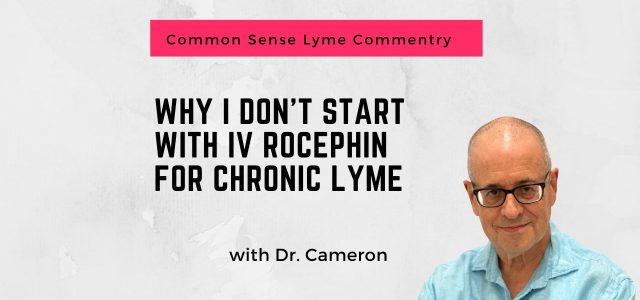Call for your appointment today 914-666-4665 | Mt. Kisco, New York

Intravenous (IV) Rocephin, or ceftriaxone, is often viewed as the gold standard for late-stage Lyme disease. And yes, it has an important role. But in my practice, I don’t routinely start with IV treatment—even for patients with chronic manifestations like fatigue, brain fog, nerve pain, or autonomic dysfunction.
Let’s break it down—in the form of a clinical dialogue.
💬 A Clinical Dialogue on IV Rocephin and Chronic Lyme
Cameron: One of my patients had been struggling for months with memory issues, joint pain, and shooting nerve pain in her legs. She asked me, “I’ve heard IV Rocephin works for people like me. Should we start there?”
Colleague: That’s understandable. People often feel that if symptoms are serious, treatment should be aggressive—and IV seems more powerful.
Cameron: Right. But more aggressive doesn’t always mean more effective. I’ve had many patients improve significantly with oral antibiotic combinations—especially when treatment also targets co-infections like Babesia or Bartonella. Jumping straight to IV may overlook important steps.
Colleague: So you’re saying oral treatment can be enough for chronic symptoms?
Cameron: In many cases, yes. Chronic Lyme isn’t just about killing bacteria—it’s about reducing inflammation, treating co-infections, and restoring immune balance. Oral regimens, when well-chosen and monitored, often do that effectively—without the risks that come with IV lines.
Colleague: When do you consider IV Rocephin?
Cameron: I reserve it for cases where oral treatments haven’t worked, or when neurologic symptoms clearly call for it—like Lyme encephalopathy, meningitis, or significant central nervous system involvement. But I don’t lead with it. Most of my patients never need it.
🔬 What the Research and Experience Show
-
IV Rocephin is effective for certain late neurologic Lyme cases, including meningitis and encephalopathy confirmed by spinal tap or imaging.
-
However, oral combinations—such as doxycycline, azithromycin, and cefuroxime—often provide comparable symptom relief in chronic Lyme, especially when co-infections are treated.
-
Clinical trials have had mixed results with IV Rocephin in chronic Lyme. Some showed improvement, others no better than placebo—often because they didn’t treat co-infections or because patients were years into illness.
-
IV treatment carries risks: catheter infections, biliary sludge, gallbladder issues, and cost burdens. It also changes a patient’s lifestyle—daily infusions, line care, and potential ER visits if complications arise.
⚖️ Why Clinical Judgment Still Matters
-
Not every patient with chronic symptoms has neurologic Lyme requiring IV
-
Oral treatment allows flexibility, fewer complications, and often strong outcomes
-
I monitor patients early—usually before week four—to assess response
-
I escalate to IV only if oral therapies plateau or if central nervous system signs demand it
-
Lyme is complex, and each patient’s path to healing is unique
🩺 What I Do in My Practice
-
I begin with a detailed clinical history—tick exposure, early symptoms, and system-specific complaints
-
I assess for co-infections like Babesia and Bartonella early, as they influence treatment response
-
I start with oral antibiotics tailored to symptoms and expected pathogens
-
I reassess frequently to adjust treatment if breakthrough symptoms appear
-
I consider IV Rocephin only after careful review—when oral regimens aren’t enough or the clinical picture clearly calls for it
🧭 Final Thoughts
IV Rocephin is a powerful tool—but like any tool, it needs to be used wisely. Starting with it prematurely may not only be unnecessary—it may delay more nuanced treatment that better matches the patient’s actual illness.
Most of the patients I see with chronic Lyme manifestations improve with oral therapy, targeted treatment for co-infections, and close clinical follow-up.
That’s why I don’t start with IV Rocephin by default.
Start where it makes sense. Treat what’s likely. Escalate only if needed.
That’s the approach I’ve found to offer the most consistent—and lasting—results.




I think Dr. Richard Dubocq would agree.
He stressed that sort treatment times with high dose antibiotics doesn’t work well with a slow dividing organism such as B. burgdorferi. He felt that time was the most important factor and would tell his patients this is a marathon, not a sprint.
I have found a marathon approach quite helpful
Thank you! This is perfect for people with Lyme to take to their Drs as well as explaining to sick people why there are no instant cures.
Do you have a list of coinfections I should ask my doctor to test for? I live in Canada just north if the Minnesota border at Lake of the Woods, (here they blame the migratory birds in the area for heavy tick infestation loads).
I am quite suddenly having a lot of pain in joints and muscles even tho I have been treated and noticed the lyme infection early.
Thank you for your work in helping everyone,
Ingrid